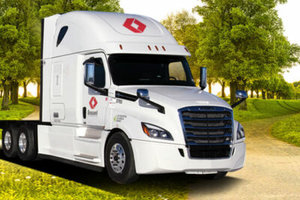Brossard Leasing - 50th anniversary
Reducing Idle Reduces Environmental Footprint and Operational Costs and We Have Solutions for That!

At any time of the year, you have certainly noticed truck drivers that leave their engines running for long minutes while waiting to load or unload. This is what we call idling and it’s expensive both from a greenhouse gas production and from fuel cost stand point when it’s done for no reason. On top of it, it is the worst running condition for any modern truck engine with aftertreatment.
At idle, running temperatures are not high enough for the particulate filters that need high heat to burn off soot. The more you accumulate idling, the more the aftertreatment system is compromised and this inevitably leads to major failures. The other problem here is fuel consumption and the costs involved. When an engine is turning at idle for no reason, it burns off 4 liters of fuel every hour and this results in wasted consumption that adds up quickly.
For a 10 truck day-cab fleet for example, at 1.5 hours of idle per day, it’s 75 hours a week, 3900 hours per year, 15 600 liters of fuel, about 20 000$ in potential savings, about 20 000$ in potential savings!
Most of the time, the question is: why leave the truck running? Would you leave your car running in the parking lot while you do your errands? Of course not. However, for truckers that must stay in their trucks, there is a question of security and comfort during extreme temperatures that has to be taken into account. During intense cold periods or periods of excessive heat, it becomes essential that the engines run at idle to get heat or air conditioning. For the rest of the time, which counts for most of the year in our area, there is no justification.
To face the problem, you can count on Brossard leasing’s consulting services. Our lease consultants will know how to guide you after having completely understood the details of your operation.
Here are a few solutions:
1. We have the tools to completely understand the particular case of your fleet.
We will want to know, on average, how much as a percentage of total engine hours is your fleet running at idle?
At what point can we consider it as a problem?
2. We will work on engine parameters and program them according to your operation.
For example, allow idle when outside temperatures are above X or below Y.
This way, idling will only be possible when done for the right reasons.
3. We can also look at installing auxiliary heating systems.
These systems heat the cabin with the truck engine off, securing a comfortable and safe driver environment while reducing consumption by 75%.
Ask one of consultants that will guide you towards and adapted solution.
Other Articles That May Interest You
Transportation Electrification Partnership : Brossard Leasing, Cléo and Globocam
Brossard Leasing Commences the Electrification of its Heavy-Duty Truck Fleet with GLOBOCAM and Cleo's Turnkey Charging Service




